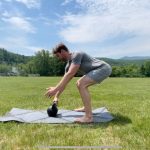Once you have mastered the kettlebell swing it’s time to add other power exercises to your repertoire. Enter the single-arm kettlebell swing. Like the kettlebell swing it’s a hinge dominant movement that engages even greater core activation. Instead of having both hands on the kettlebell, you are simply using just one. Using only one hand on the kettlebell requires your body to overcome rotation, forcing the core to brace and stabilize the spine.
Muscles Used in the Single-Arm Kettlebell Swing
The Single-Arm Kettlebell Swing primarily works the gluteus maximus, hamstrings, rectus abdominis, obliques, rhomboids, trapezius, deltoids, and quadriceps. Below is a short video on the proper mechanics of a single-arm kettlebell swing:

How to set up for the Single-Arm Kettlebell Swing
- KB starts out 10-12 inches in front of you
- Hinge your hips back and slightly down to reach the KB
- Keep your upper back engaged by not allowing the shoulder to round forward
- Angle the KB handle towards you
Single-Arm Kettle Bell Swing Mechanics
 Hike
Hike
- Hike the KB behind your hips using an aggressive shoulder/lat movement (I like to think of a straight-arm pulldown which engages the latissimus dorsi and trapezius)
- When hiking keep the arms high up towards your glutes
- Keep the shins vertical and the back remains in neutral spine thoughout the entire exercise
- Lead with the hips as you propel the kettebell through the legs
- Think of being explosive, the same way as you would sprint or jump; this is not meant to be done slowly.
Top of Swing

- Hips and knees should be fully extended
- Arm does not lockout but is near the torso
- Bottom of KB should always point forward at the very top
The opposite arm (throughout the entire movement)
The opposite arm that is not in contact with the KB should be following through and mirroring the action arm. This helps prevent rotation and proper alignment reducing the chance of injury. You will also achieve greater hip extension when following through with the opposite arm (without the kb).
[sc name=”plyometric” ]
Common Mistakes
- Using the arm to swing the bell (make the hips lead instead, propelling the arm forward with momentum)
- Squatting to swing the bell (swings are hinges not squats)
- Not following through with opposite arm
Get Swinging!
One of the nice aspects of training with kettlebells is the versatility and adding in single-arm kettlebell swings is another great movement to increase power, strength, and conditioning. Knowing how to do this exercise takes practice and attention to doing it correctly but once you get it you will take your training to the next level. Start light and progress gradually. Always master the form and add weight over time.

